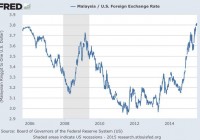3 Country ETFs Impacted By China’s Currency Devaluation
Wise were those analysts who had foreseen the start of a currency war post China’s yuan devaluation story. China shook the global markets on August 11 when its policymakers devalued the country’s currency by 2% against the greenback to boost its sagging exports. This resulted in the largest single-day decline since the historical devaluation in 1994 . Though the Chinese central bank defended its currency intervention ‘as a free-market reform’, global experts’ apprehensions of a currency war in the near future, especially among its Asian neighbors, are turning into a reality. Most export-centric economies will likely be forced to depreciate their currencies to stave off competition and rev up their exports. And analysts were not wrong at all, as this currency war is already underway. Let’s take a look at the country ETFs which were hit hard by the yuan devaluation. Vietnam To fight against the dark impact on its exports, Vietnam weakened its currency, dong, on August 19. This was the third time that the country devalued its currency this year and the second time in a week. The trading band has now has been widened to 3% from 2%, per Reuters. Like China, Vietnam also acts as a low-cost producer and earned some edge over China in recent times, as Chinese wages are on the rise. With a stronger currency, Vietnam would lose this competitive advantage. Not only exports, Vietnam is unable to sell products to domestic consumers due to the surge in cheaper Chinese imports, resulting in a widening trade deficit. In the first seven months of 2015, deficit in trade with China was $19.33 billion, worse than $14.88 billion of deficit in the year-ago period, according to Reuters . Following the latest depreciation in currency, dong fell 4.5% in interbank on August 18. In the last one month, the greenback gained 2.3% against dong. The Market Vectors Vietnam ETF (NYSEARCA: VNM ) – the pure play on Vietnam – lost about 5% in the last five trading sessions. Malaysia The Malaysian equity market has been an impacted area post the yuan devaluation. Also, a falling oil price marred the stocks of oil-rich Malaysia, which happens to be one of the largest Asian crude exporters. Political crisis is another cause of concern for Malaysia. On the other hand, China’s currency devaluation hurt its competiveness as an exporter. This, coupled with a strong U.S. dollar amid the looming Fed rate hike, recently sent Malaysia’s currency, ringgit, to a 17-year low. This resulted in the depletion of Malaysia’s foreign exchange reserves, and in turn soured investors’ mood toward Malaysian investing. Ringgit fell over 7% in the last one month against the U.S. dollar. Pure play-Malaysia ETF, the iShares MSCI Malaysia ETF (NYSEARCA: EWM ), was off 17.9% in the last one month (as of August 20, 2015). Indonesia Following the yuan move on August 11, Indonesia’s currency, rupiah, tumbled the most in 2015. This currency also touched a 17-year low after the yuan episode. Rupiah was the second worst-performing Asian currency this year. The country was already grappling with weak exports and a five-year low GDP growth. Indonesia ETF, the iShares MSCI Indonesia ETF (NYSEARCA: EIDO ), was down over 14% in the last one month. Original Post
